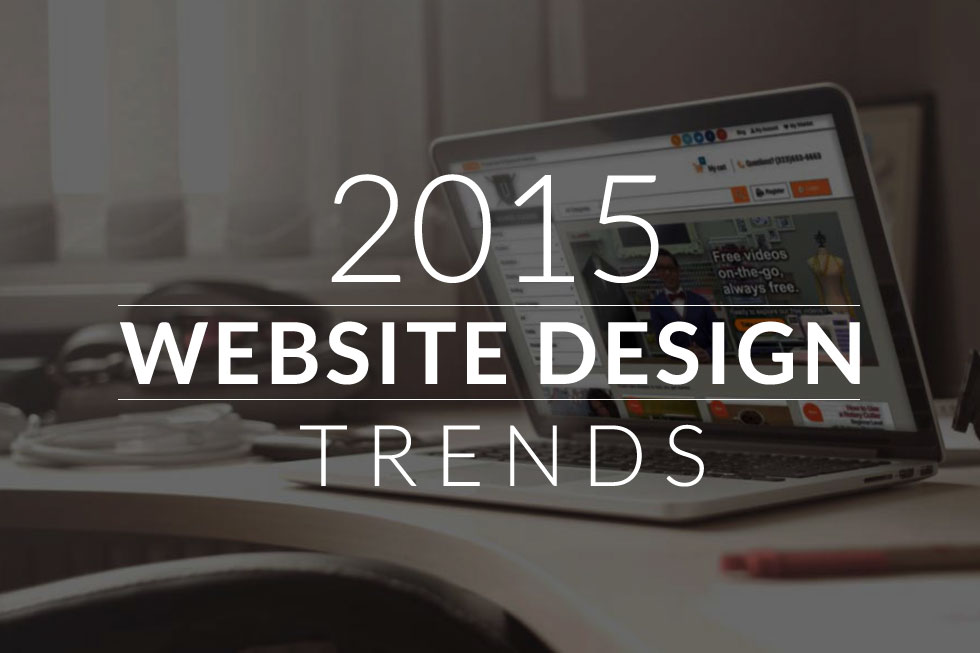
As we move into 2015 all our custom web designs will be fully responsive. This is key in how your visitors view your website with mobile technology and search engines ranking your site.
The 5 Best Web Design Trends to Look Out For In 2015
As the web becomes more and more advanced and complicated each year brings new techniques in the world of web design with things moving fast. While some ideas transform into standards and continue to become part of our digital spaces others fade away soon. Here’s a look at five of the new trends that we’re likely to see this year.
Less Clicks, More Scrolling
With there being no ‘above the fold’ content anymore scrolling has turned increasingly popular over the last year. The scrolling experience has become more visually attentive for users having to scroll through a page to get their information than to constantly click to find information. Scrolling is far quicker than clicking and helps convey masses of information without slowing down the experience for the user. It is also usually faster than regular webpages, mobile and touch friendly, and a non-committal action that requires little thought. It puts all your content on one endlessly long page within a “scroll’s reach” and as mobile devices become more popular, it’s becoming more commonplace for sites to opt for scrolling instead of linking as a means to display content.
Big Typography
Big fonts are expected to make a comeback this year. Big Typography gels well with the less is more approach and helps the website audience navigate better and faster through the website as everything is clear and they do not have to search the web page for the focus of the web page. With Type kits becoming more affordable (or free in the case of Google Fonts) web designers have an overwhelming choice of cheap yet quality font families. While large typography is likely to be king, responsive typography will also be at the helm of trends with varying view ports demanding functional, responsive & versatile typography that will allow users to read text with excellent clarity across any device.
Simplicity & Hidden menus
The use of simple innovative design that creates an engaging, humane experience worth repeating is a given. Removing non-essential design elements to keep a site simple will be the new trend that takes center stage this year. One technique of responsive design that is starting to be carried over into all of a site’s design is “Hidden Menus”. Similar to the 2014 trend of the hamburger menu, hidden menus keeps the links hidden away and only become visible until the user needs access and interacts with an element towards the top left of the screen. It’s becoming more popular for websites to hide their left-navigation off screen and one can anticipate seeing more sites adopting this. With Screen real estate being a precious commodity on mobile devices Hidden menus are popular among responsive layouts because they clear room for page content.
Responsive Design
Over the last few years responsive design has solidified itself as the new standard for web design and will continue to be a must in 2015 with greater emphasis placed on performance. Web designers will need to shift their focus towards adaptable, flexible, Responsive re-sizing, image optimization and highly responsive HTML5 videos. Card Design (while not new) is clean, and simple with a lot of versatility it’s a great tool for designers working on responsive websites and will continue to get better with more and more application in an increasing variety of places.
The Rise of Material Design
Inspired by the aesthetics of “Flat” design, “Material Design” is Google’s conceptual framework for how digital products should be laid out and rationalized with emphasis on mobile. While the biggest trend in 2014 was Flat Design Google’s aesthetic will pave the way for mass adoption since it allows designers & developers to use it in any end-framework they want. It looks extremely promising and is definitely one trend to look forward to. That’s not to say that Flat design will fade away. Quite possibly it will continue to be popular in 2015 due to its clean, simplified style that allows for optimized performance on mobile devices. One could speculate that Material Design is where flat design as a whole is headed, ultimately evolving into “Material Design”.
In conclusion, with new patterns emerging every day, we are moving towards simplification and accessibility of the web as a whole. Web aesthetics is continuing to diversify, and while the dominant trends of 2014 look as if they will carry on into 2015, the web will always be in continuous development with the future of these trends being decided by how far we push and adopt them.
Article Courtesy of Clinton Gonsalvez

